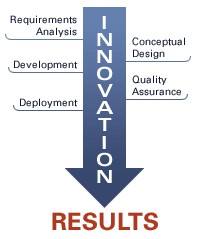|
|
| |
Home > Articles > General > ArticleItem
|
3/22/2006 9:33:16 PM
Elizabeth C. Lempres
A product is born The process of product development could itself stand a bit of development. Studies indicate that nearly two out of three new products fail after launch. Compounding that, companies in many sectors are under continual pressure to speed up the pace of product development—even to adapt products that are still in the pipeline to the demands of a constantly changing marketplace. A new formula is needed. The process of product development could itself stand a bit of development. Studies indicate that nearly two out of three new products fail after launch. Compounding that, companies in many sectors are under continual pressure to speed up the pace of product development—even to adapt products that are still in the pipeline to the demands of a constantly changing marketplace. A new formula is needed.
Companies have stepped up to such challenges in the past. Some market leaders can rightly boast that they have reduced, by a third or more, the time needed to develop and launch new products, while squeezing costs and quality problems out of the process. But recent efforts have yielded largely incremental performance gains: progress in speeding up development cycles is faltering, and even products pumped to market in a heartbeat fail to win customers far too often.
The problem is the process, which in most companies has become an inflexible sequence of activities, like a production line. Because it is inflexible, it is disconnected from marketplace changes that may determine the fate of new products. The solution is to inject more customer-related information into the process and to make it flow better. By transforming a rigid process into a more dynamic and information-based one, companies can quicken the pace of development and improve a product’s odds of success.
But to do so, they will have to implement basic changes in the way they make and time product-development decisions, as Richard Holman, Hans-Werner Kaas, and David Keeling show in "The future of product development." By improving the quality, timing, and synthesis of information throughout the development cycle, companies can free themselves from prescheduled project time lines and formalized process steps and manage their resources and work flows more flexibly. They can keep their product options open longer, act on market information later, and reduce the delays, bottlenecks, rework, and wasted effort inherent in today’s assembly-line product-development process.
Many companies should also change the way they price new products. Although most markets exert intense pressure to keep prices low, a wide range of new offerings could actually command higher ones. Companies are particularly prone to underprice revolutionary products, since it is all too easy to underestimate the value to customers of new features and attributes. In "Pricing new products," Michael V. Marn, Eric V. Roegner, and Craig C. Zawada provide a way out of this trap. They demonstrate how a company can systematically determine the full range of possible prices for a new offering and then assess the factors that could justify setting its price high.
More broadly, companies need to rethink their processes for choosing growth options—including which new products they should pursue. For the past 20 years, they have survived tough times by squeezing costs to improve their operating performance, but companies also must not forget to foster more creative, growth-oriented initiatives to get revenues rising again. In "Managing for improved corporate performance," Lowell L. Bryan and Ron Hulme explain how large companies can establish a process that allows line managers and senior executives to identify, review, and choose promising longer-term, growth-oriented corporate initiatives collaboratively—while maintaining tight control over operating performance.
Finally, this issue of The McKinsey Quarterly features a timely look at the US defense industry. In a post-cold war world, the nature of the threat is changing while technology is transforming the way war is conducted—upending the strategies and structure of the US defense industry, to say nothing of how buyers and sellers interact. In "What transformation means for the defense industry," Douglas S. Harned and Jerrold T. Lundquist explain the forces for and against change and show how the future may shape up for large and small contractors alike.
-----------------------------------
Source: McKinsey Quarterly
|
------------------------------------
|
|
|
|
|
|
|
|

Receive our newsletter and updates of GCG activities
|
| |
|
|
|